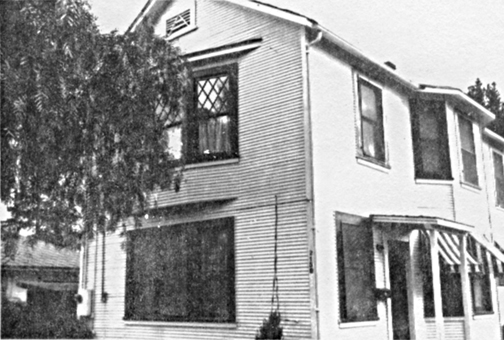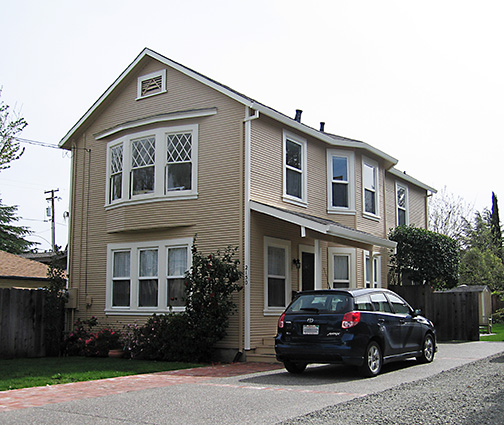 Palo Alto Stanford Heritage
Palo Alto Stanford Heritage |
 |
| Inventory photo | 2006 photo |
The following is from the Historic Buildings Inventory as revised in 1985:
This two–story vernacular building, stylistically undistinguished though loosely connected to Colonial Revival forms, is of interest principally for its historical associations.
This plain building was erected on a site sold in 1897 by Alexander Gordon to Alexander Peers (both being significantly involved as developers of College Terrace and Mayfield). Peers evidently had the house built in 1904 and turned it over to the J. J. Morris real estate firm of Palo Alto for sale in 1905 to Mrs. M. A. March and her daughter Mrs. Adelaide M. Coburn. As the Marchmont Club, it served as an eating club for Stanford students in the early years of the century.
After World War I, it became a single–family rental property, owned between 1930 and 1946 by James Christie. Christie was employed for many years by the Santa Fe Railroad; here, he was the gardener in charge of the Stanford University cactus garden. His wife, Anna, was a practical nurse at the university's Men's Rest Home.
The building had several notable university families as tenants. Professor John Almack, who lived in the house briefly in the 1920s, was a nationally–prominent educator. During the heyday of "progressive education" and "social studies" in the 1920s and 1930s, he argued for emphasis on fundamental skills.
Tenants in the 1930s included Harold H. Fisher, distinguished authority on Russia and director of the Hoover Institution at Stanford, and Professor and Mrs. Victor C. Twitty. Professor Twitty was a member of the biology faculty at Stanford. Florence Twitty taught art at the Peninsula School and in the Palo Alto adult education program, and was the receptionist of the university Art Gallery.
In 1946, the house was acquired by George S. and Frances F. Myers, and has remained in the Myers family since then [1978]. Both the Myers took their undergraduate and graduate degrees in the biological sciences at Stanford, and Professor George Myers was on the university's biology faculty, 1936–1970. After retiring from Stanford, he was visiting professor at Harvard, holding the Biglow chair in Ichthyology and the Agassiz chair in Zoology. In 1958–59 he was on the organizing committee for the First International Congress of Oceanography held at the United Nations.
This house was built in 1906 and is a Category 4 on the Historic Buildings Inventory. The builder may have been L. S. Bean. Albert Coburn built the barn in 1907. The lot is 50 x 125 feet.
Sources: Palo Alto City Directories; Palo Alto Times 9/14/04, 6/2/06, 10/17/07, 10/6/53, 10/16/71, 7/17/83, 8/3/85; San Francisco Chronicle 11/17/75, 11/27/85; Palo Alto AAUW, ...Gone Tomorrow?; Book 202 (Deeds), p. 10–12, 8/24/97; Book 278 (Deeds), p. 51–53, 4/14/04; Book 296 (Deeds), p. 411, 8/22/05; Book 1409 (Official Records), p. 198, 9/13/46 (Santa Clara Co. Recorder)
E-mail us at either webmaster@pastheritage.org or president@pastheritage.org.
![]() Palo Alto Stanford Heritage—Dedicated to the preservation of Palo Alto's historic buildings.
Palo Alto Stanford Heritage—Dedicated to the preservation of Palo Alto's historic buildings.
Copyright © 2015 Palo Alto Stanford Heritage. All rights reserved.